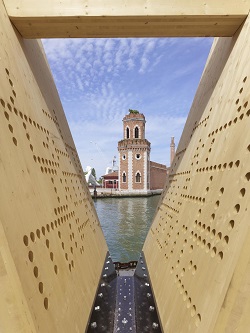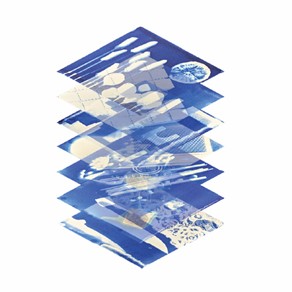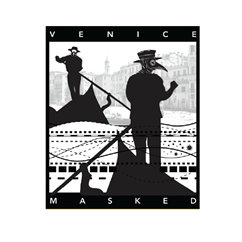Venice Biennale
Multiple projects with ties to The Cooper Union are on view in Venice this year, as part of The Venice Biennale of Architecture 2021.
Projects by Cooper faculty include Microcosms & Schisms, a project by The Irwin S. Chanin School of Architecture Associate Dean Hayley Eber AR'01 and Architecture faculty Nora Akawi, Lydia Kallipoliti, Lauren Kogod, and Ife Vanable exhibiting in the Co-Habitats section of the Biennale. Two projects by Dean Nader Tehrani’s architecture and urban design firm NADAAA, a portico and a house prototype, are also on view. David Gersten AR'91 is a featured exhibitor in the Italian Virtual Pavilion with SunShip: The Arc That Makes The Flood. School of Art Adjunct Instructor João Enxuto and his collaborator are showing their work 2038 – The New Serenity in the German Pavilion.
Alumni projects include Conceiving the Plan by Yael Hameiri Sainsaux AR'10, which honors the late Irwin S. Chanin School of Architecture Professor Diane Lewis AR'76, opening in October in the Italian Pavilion. Michael Morris AR’89’s SEArch+ / Space Exploration Architecture firm's The Lunar Lantern will be on view in the virtual Italian Pavilion. Peggy Deamer AR'77 is an exhibitor in Platform Austria, on view in the Austrian Pavilion. Jesse Reiser AR'81 and Nanako Umemoto AR'83’s firm Reiser + Umemoto is bringing Geoscope 2, a panoramic multimedia experience, to the Biennale. Dorit Aviv AR'09 and fellow designer-educators from the Weitzman School of Design at the University of Pennsylvania present their work in the Italian Pavilion. Natalie Savva AR'13 is among the contributors to Anachoresis Upon Inhabiting Distances, on view in the Cyprus Pavilion. John Lin AR'02’s firm Rural Urban Framework presents an installation that investigates Chinese exurbs.
TimeStills by alumna Elena Fanna AR'03 is part of the 2021 ECC Architecture Biennale at the European Culture Center in Venice. Venice Masked 2021 is by alumni of all three schools and is curated by Paola Barcarolo, Frank Gerard Godlewski AR'82, Drew Knapp A'75, Margaret Matz AR'83 of Milestone Architecture PLLC, and Donato Giacalone AR'83 of Salam & Giacalone Architects PC.
The Cooper Union’s legacy and visibility at the Venice Biennale, which was established during the 1970s, is being continued in an exceptional way through the works of these projects. The 17th Venice Architecture Biennale runs through November 21, 2021.
Please see below for more details on a selection of projects.
List of participants and projects in formation as of September 23, 2021. If your project or another alumni project is not represented here, please contact us at alumni@cooper.edu.
Microcosms & Schisms:
Exhibition: Hayley Eber AR'01, Nora Akawi, Lydia Kallipoliti, Lauren Kogod, Ife Vanable
May 22 - November 21
Websites: https://microcosmsandschisms.com
https://www.labiennale.org/en/architecture/2021/co-habitats

Veneta Porta Lignea:
Exhibition: NADAAA
Arsenale, Exterior
May 22 - November 21
The Giardino delle Vergini occupies a critical location in Venice, at once a destination at the end of the Arsenale, but also its gateway as one arrives by boat. Metaphorically, the Biennale as venue, rarely offers an opportunity for an extended “essay”; its budgets and sites are better aligned with something akin to haiku: in brevity, with assembly and disassembly strategically conceived. As such, this has been an opportunity to recall the symbol of Venice, the winged lion of St. Mark who holds the welcoming words in an open book to the waters: Pax Tibi Marce Evangelista Meus.
With an eye towards optimization, we have adopted a panel of cross-laminated timber as a single member into which we may carve and stencil – without waste, articulating a base, a shaft, and a lintel whose function is to frame the threshold into the Giardino. The base serves as a wood foundation, liberating it from any penetration into the Venetian soil. The “piloti” is triangulated, a figural “V”, and an allusive registration of the open book containing Venice’s welcoming words – all while framing a view of the fortification tower beyond the lagoon. The lintel is displaced asymmetrically, cantilevering over the passage of arrival, pushing the structural capacity of this installation to its limits; a stone of Venice maintains it’s balance on the opposing end. Set on the stones of the fondamenta, this wood construction is a reminder of the very wood piles that hold up this maritime city.
Website: https://www.labiennale.org/en/biennale-channel/biennale-architettura-2021-sneak-peek-nadaaa

Other Ways of Living Together:
Exhibition: NADAAA
Arsenale, Interior
May 22 - November 21
The built landscape has taken on a global scale. There is little on the earth that has not been impacted by the human footprint. How we live together and where we live is described by great environmental diversity from the urban to the rural with the suburban and industrial territories in between. There are certainly other spaces also, but the predominance of these four stands out, and we have examined them with a few principles in mind. The first revolves around an ethic of Existenzminimum whereby the density, flexibility, and efficiency of residential buildings are challenged once again from an architectural vantagepoint; a legacy of the 20th century, this is a moment of reckoning in relation to current environmental and social challenges. Secondly, because of this first ethic, many typological conventions and code constraints may require reconsideration in order to imagine other ways of living together. We have probed certain loopholes in each case study to unleash certain plausible eventualities, drawing from common standards, but overturning them in the interest of invention. Thirdly, all these studies emerge from a common interest in mass timber and in particular the relationship between cross-laminated timber and stud framing, the first being described by the combination of structural and thermal mass while the second being characterized by its hollow cavity, enabling the threading of mechanical, electrical, and plumbing services within a structural wall. Traditionally seen as independent or mutually exclusive, here we will present these two systems as symbiotically co-dependent. The sites of these studies revolve around the greater Boston area, but their implications may be as relevant for many other international regions.

Plan of Norrköping Sweden at scale 1:10,000, linoleum block print (verso side), Peter Lynch AR'84, for "Timescape Garden" project. Photo Credit: Jean-Baptiste Béranger
Conceiving the Plan:
Nuance and Intimacy in the Construction of Civic Space
In Honor of Diane Lewis (1951 –2017)
Exhibition: Yael Hameiri Sainsaux
Opening: October 8
The Italian Pavilion of the 17th Venice Architecture Biennale
Composed of a series of post-2020 civic architecture projects for different sites, Conceiving the Plan inaugurates a dialogue with the legacy of the late architect and longtime Cooper Union Professor Diane Lewis. It asks the following questions: how can civic spaces be imbued with nuance? In what says does such a quality persist in the city? Can one discuss intimacy in architectural terms? For Diane Lewis the city was not only the result of a great number of historical, and ultimately inextricable, strata of form and memory; it was also greater than the sum of its individual architectures and a mental universe all its own. Lewis’ unique presence and unmistakable voice is among the most characteristic distillations of the architectural “message” of Cooper Union from the 1970s to the mid-2000s, captured here in a videos series originally made for Open City. Architects, former students, colleagues, and friends generated projects as a continuous discourse with Lewis’ pedagogy, carrying her legacy into contemporary dialogues by generating comprehensive architectural projects. The projects touch on critical questions—narratological, ecological, social and metahistorical—providing and provoking spatial civic identities. Thus, the projects also, are inseparable from deeply involved critical approaches to pedagogy in the architectural discipline. Conceiving the Plan publication is now confirmed with Skira and scheduled for spring release.
Website: https://www.conceivingtheplan.com/

TimeStills - 2021:
Anthology of the Now and Blueprint of the Future
Exhibition: PorterFanna Architecture, New York
Cyanotypes on watercolor paper, multiple participants worldwide
European Cultural Center, Palazzo Mora, Strada Nova 3659, Venice, Italy 30121
May 22 - November 21
TimeStills begins as an investigation into the meaning of time and inhabitation as lived by the individual and evolves into the documentation and merging of a global narrative. The medium of cyanotype is used to create and assemble photograms recorded by participants all over the world, displayed here as a composite visual diary.
Website: www.timestills.design/time-stills

Venice Masked 2021:
Architecture for Human Spaces
Exhibition: Paola Barcarolo, Frank Gerard Godlewski, Drew Knapp, Margaret Matz of Milestone Architecture PLLC, Donato Giacalone of Salam & Giacalone Architects PC
Venice Masked 2021 is a curated exhibition to open a dialogue on the future of public space from a critical standpoint and re-imagine Venice’s immediate future.
Venice Masked 2021: Architecture for Human Spaces is held virtually in Venice from May 22 - November 21 and in New York during Conceiving the Plan Opening, Events, Symposium, Screening: October 8 - 10, to coincide with The Venice Biennale of Architecture 2021.
May 22 - November 21
An Architectural Space can resonate with a multitude of frequencies, from the physical to metaphysical, sociological, and spiritual. This is the distinction between a building and architecture. Architecture can be both the form and void spaces, each equally weighted and considered in relation to the inhabitation whether explicit, implicit, or virtual. Public squares, ports, canals, basilicas, and many other public spaces share a connective relationship with one another that speaks to the underlying lineage of the city of Venice.
Website: https//:www.venicemasked.org




